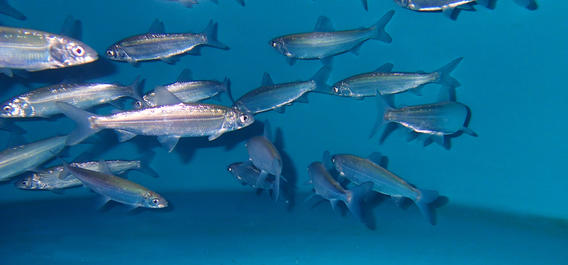
Native cisco are an economically, culturally, and ecologically important coldwater fish.
Challenge: Restoration efforts for native fishes are impeded by changes to water temperature from a warming climate, and unintended impacts to water clarity from the suppression of nutrient run-off.
Principal Investigator(s):
- David Bunnell (Great Lakes Science Center)
Co-Investigator(s):
- Gretchen Hansen (University of Minnesota)
- Abigail J Lynch (Climate Adaptation Science Centers)
- Craig Williamson (Miami University)
- Nicole Berry (Miami University)
- Erin Overholt (Miami University)
- Peter Jacobson (Minnesota Department of Natural Resources, retired)
- Tyler Ahrenstorff (Minnesota Department of Natural Resources)
- Casey Schoenebeck (Minnesota Department of Natural Resources)
- Joseph D Schmitt (Great Lakes Science Center)
- Charles P Madenjian (Great Lakes Science Center)
- Kevin M Keeler (Great Lakes Science Center)
Partners:
- Miami University
- University of Minnesota
- Minnesota Department of Natural Resources
Coregonines are a sub-family of freshwater fishes within the well-known Salmonidae family. In the upper midwestern U.S., these fishes have provided a key food source to Native Americans for millennia and immigrants for the last several centuries. Since the mid-20th century, however, their diversity and abundance has declined owing to several anthropogenic stressors including overfishing, declining quality of key habitat (e.g., dams, eutrophication), and negative interactions with invasive species. Managers of inland lakes in Minnesota and of the Great Lakes in Michigan, Ontario, and New York, and several U.S. Tribes have undertaken various efforts to restore coregonines, including cisco (Coregonus artedi). For example, Minnesota has invested in land use conservation efforts to reduce nutrient runoff that can reduce cisco habitat. Likewise, managers in Lake Erie have begun exploring the feasibility of reintroducing Cisco but have identified a warming climate as a key threat to investing in this plan.
The research team will investigate whether southern stocks of cisco (e.g., in inland lakes in Indiana, Pennsylvania, or southern Michigan) can tolerate and thrive in warmer water temperatures better than northern stocks of cisco (e.g., in Lake Superior). The research team will also investigate whether reducing nutrient runoff in cisco restoration lakes will cause the unintended consequence of increasing water clarity to the point that eggs and larvae of cisco will experience increased mortality due to increased exposure to ultraviolet (UV) radiation. The results of this research will directly benefit management decisions in these two regions of the midwestern US. In Minnesota, for example, this will ensure that the investment in reducing nutrient runoff will have the intended positive effect on cisco restoration and also lay the groundwork for future research to determine whether reduced ice cover is reducing cisco reproductive success. For the states of Ohio, Michigan, New York, Pennsylvania, and the province of Ontario, this research will inform their cisco reintroduction decision and ideally identify the source population best adapted to a warming Lake Erie climate.
Read more from the CASC Project Explorer.
